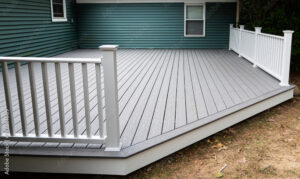A home deck is perfect for entertaining, family relaxation, and outdoor cooking. Most communities require a permit and a home inspection to ensure the structure is up to code. A home deck is a great way to make the most of your outdoor living space and add value to your home. , it is important to use the right materials for the job to ensure a safe and stable structure. To find out the perfect deck for your home, visit https://deckbuilderscharleston.com/

Common building materials include pressure-treated wood, gravel, and concrete footings or piers. The foundation for the deck is a key element that determines the stability of the entire deck. Ideally, the foundation should be on a solid footing or pier, not directly attached to the house. The best type of material for this purpose is poured concrete. You will need a shovel, a jackhammer or other demolition tools, and concrete to construct the foundation. You will also need 2-by-6-inch pine boards for forms and steel stakes. Before starting the project, consult a blueprint or plan and read some books on deck construction. It will help you understand the different steps involved in building a deck.
The type of wood used for the decking can greatly impact cost and workability. The most common option is treated pine lumber. It is durable and can be stained or painted. It is also environmentally friendly, and many builders prefer it to cedarwood. Another option is composites, which are made of a blend of recycled plastic and waste wood fibers. They look like real wood and come in a variety of natural-looking hues. They also resist mildew and splinters. Although they are more expensive than real wood, they may be cheaper in the long run.
Once the decking and other structural materials are in place, the joists and beams need to be fastened to them. It is important to use a power sander for this process. You should also wear a dust mask to remove toxins from your nose and lungs. Using the correct sandpaper grit would be best to avoid damaging the wood. Once the deck is finished, it must be properly sanded before staining and each time before new layers of stain are applied.
Before you build a home deck, it’s important to think about its design. The style should be in keeping with your home’s overall look so that the deck feels like an extension of the house rather than a separate structure. Moreover, the deck should be safe and practical for you and your family. A good way to ensure this is to get the right estimates from professional contractors. Be sure to have them come to your home so they can take accurate measurements and see any obstacles that may affect the layout of your deck.
The first step in designing your deck is to determine its location. It will depend on what you intend to do with the space, such as large parties, family relaxation, or outdoor cooking. You will also want to consider the amount of sunlight and shade you desire. For example, a deck on the east side of a house will provide more shade in the afternoon than one on the west.
If your deck is to be open to the weather, you’ll need to add a roof or awning for protection from rain and direct sun. In addition, you’ll need to factor in the potential for snow load on the structure and plan accordingly.
Various materials can create contrast and visual interest on a deck. For example, combine wood with stone walkways or install copper post caps on your railings. Using different stain colors can also create a striking effect.
Before starting construction, it’s a good idea to review local codes and regulations on the size and type of deck you can build. In some jurisdictions, you may need a permit to construct a deck. Obtaining the necessary permits before beginning construction can help you avoid costly delays and legal complications.
It’s also a good idea to check with your homeowners’ association or neighborhood homeowners’ committee to learn about any restrictions. Some communities and neighborhoods may require that a deck be built with certain materials or constructed within a certain height range.
If you’re considering adding a deck to your home, you should first figure out how much it will cost. The amount you spend will be largely determined by the size of your house and how large or small you want the deck to be. In addition, the cost will also be determined by the type of material you choose and any additional design features you might like to include, such as a staircase or pergola. You may need to apply for a permit for your deck, and the price of these can vary by municipality. It would be best to remember that a deck can increase your property taxes, so be sure to check with your local tax collector for more details.
Another important factor to consider when planning your deck is how it will be used. Some people want a place to relax and unwind, while others want a space for parties or outdoor cooking. It will help you decide the best location and size for your deck and what options you wish to incorporate, such as a built-in grill, fireplace, or hot tub.
It’s also important to consider the amount of labor needed. Some materials, such as cedar and treated pine, are more expensive than others, and the work required to build them can add up quickly. Other costs are fasteners, joist hangers, concrete, and stain or paint. These items can add up to several hundred to more than a thousand dollars, so factoring these into your budget is essential.
Building permits and the cost of labor can also vary by region. Most municipalities require a license for decks over a certain height or square footage, and the price of these can range from a few hundred to a few thousand dollars. You should also be aware that many cities and towns have rules regarding how close your deck can be to your property lines, so contact your city or town hall about this before beginning construction.
Purchasing a deck is a substantial financial investment, so choosing a contractor you can trust to do quality work is important. Start by asking for references from friends and neighbors. You can also find out more about a contractor’s reputation by searching online for reviews and information about their previous projects. Also, ask about the contractor’s insurance coverage and whether they carry worker’s compensation insurance in case of an accident.
Once you’ve identified a few potential contractors, it’s a good idea to interview them for the job. During the interview, you can learn more about their expertise and what they can do to help you create your dream deck. Some things to look for include how long the company has been in business, their methods and techniques, which materials they use, and examples of previous work. It’s also good to ask about their availability and how soon they can start working on your project.
Before hiring a contractor, it’s essential to get a written estimate. It should include a description of the work, a detailed rendering of the deck, and a breakdown of the specific materials used. The assessment should also specify the estimated time frame for completion of the work.
Meeting with the contractor face-to-face before starting the project is also a good idea. It will give you a better sense of whether their vision aligns with your expectations and the terrain of your backyard. The contractor can also explain how they plan to build the structure and address any issues that might arise during construction. For example, they suggest adding post support in an area where you’re concerned about the ground shifting over time.
It’s also good to talk with the contractor about how they handled past projects and any setbacks or glitches that arose during construction. You’ll want to ensure they can stick to their schedule and finish the deck by the expected date. If they cannot meet your expectations, knowing if you can negotiate or get out of the contract without penalty is important.
















